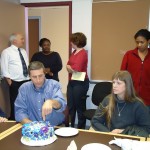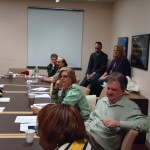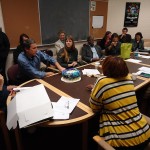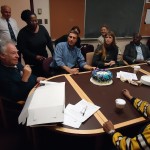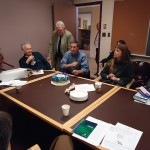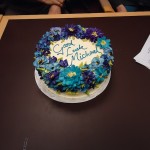
Two undergraduate English majors (Lauren Levesque and James Muller), Cathrine Frank, and I joined Michael Smith at York College/CUNY on a panel at the 2013 AAEEBL ePortfolio conference in Boston. Our panel, “Who Owns the ePortfolio,” explored some of the tensions in ePortfolios when an institution is interested in assessment but wants students to embrace the value of ePortfolio for their development and digital identity.
Our English majors offered brief tours of the ways they are putting their ePortfolios to use. And with Michael’s support, we streamed the presentation to the Web at CUNY.is/LIVE, a phenomenal free streaming service available at the CUNY Academic Commons. And we recorded the broadcast do document our students’ presentations.
Bass and Eynon
Following our panel, I attended the keynote jointly delivered by Randy Bass (Georgetown University) and Bret Eynon (LaGuardia Community College/CUNY). Their central questions as they look to the future of higher education: How do we create an integrated learning experience for students across an increasingly disintegrated set of structures and contexts? How do we assess learning holistically? How do we demonstrate educational distinctiveness?
Bass and Eynon are interested in the contributions ePortfolio might make to the future. After introducing their FIPSE-supported project entitled “Catalyst for Learning,” they articulated a set of practices that seem to yield effective ePortfolio initiatives.
- They function at campus level, with departments, and with institutional stakeholders. Successful projects work with all groups.
- Pedagogy, professional development, assessment, technology, and scale must come together if ePortfolio is to make a difference.
- Inquiry learning, reflection, integration work iteratively in successful initiatives.
Their research (based on 24 campuses) shows that ePortfolio initiatives:
- Advance learning success
- Make learning visible
- Catalyze institutional change
If the data support these conclusions – and they presented some of this data – they’re working in a space that meets a real need for the ePortfolio community. Moving beyond testimony, individual spotlights, and even department-level assessment, the “Catalyst for Learning” project seems to speak to some of today’s hot-button institutional outcomes. Some of their data point to associations between ePortfolio implementation and retention, GPA, and even graduation rates.
But what might ePortfolio have to do with the challenges of higher education? What does this future look like?
- MOOCs today look like a return to an instructor mode, an earlier teaching mode, but this will likely change
- Endless pursuit of productivity, scale, efficiency, with quality often dropping out of the conversation
- High failure rates in online learning environments may change, but this problem also points to opportunities
The discourse that emerges from these higher ed discussions is focused on data, scale, and personalizing learning through knowledge of individual learners’ behaviors.
As Bass and Eynon see it, three core principles seem to guide those involved in much of the higher education discussion.
- Technology is only way to break the access, cost, quality conundrum
- Learning processes can be understood via data analysis
- Improving human learning depends on improvement in machine learning.
The landscape in this future:
- Taking Instructivism to Scale
- Learning Paradigm on Analytics
- Productivity Agenda
As Bass describes, MOOCs focus on the fact that a large part of education is generic/interchangable. On the other side of a continuum is the local and identity-specific component of education. In between the generic and the local/experiential, Bass argues we find the high-impact integrative curriculum. The challenge is that higher education seems not to recognize these three zones, making it difficult for institutions to make this change.
For Bass and Eynon, ePortfolio may be an “agent of an integrated learning culture through evidence of impact.” If this it to happen, Bass thinks we need Integrative Learning Analytics. We need “integrative learning” analytics, ways of evaluating integrative learning. But we also need integrative “learning analytics,” a bringing together of a range of learning analytics.
Their talk was a fascinating argument for the potential centrality of ePortfolio to an institution’s effort to meet the challenges of higher education: a bridge between instruction and learning, between productivity and quality, between granular learning/metrics and integrative learning/outcomes.
This is a heavy burden for ePortfolios. While I am an advocate for ePortfolios, I’m not yet convinced they can meet this challenge. Certainly, the larger forces of education commodification, standardized assessment, and the cost containment pressures on colleges and universities are not particularly conducive to some of the more exciting elements of ePortfolios.
Big “Fail” for the Hynes Convention Center Exhibit Hall
The conference venue gets a big “fail” on its family-unfriendly accommodations in the exhibit hall. A conference attendee, presenter, and friend of mine with a toddler in a stroller was denied access to the lunch because it was held in the Exhibit Hall. The hall, it turns out, would not permit individuals under 18. Insurance liability, according to security.
And they placed lunch at the back of this “childfree zone” in the Hynes Center, so my friend couldn’t actually get to the food or network with other attendees in a structured luncheon program that involved sitting at the tables focused on specific aspects of ePortfolio and technology.
Apparently, shameless promotion of products by vendors hawking tech wares is allowed, encouraged, and monetized by the Center. Every accommodation was made to ensure vendor access to adequate power, bandwidth, and presentation space. But a conference presenter with a paid registration (and a child in a stroller) cannot get in. And a look at the swag given away by the vendors would suggest that the Exhibit Hall is actually a confectionery and toy shop: lots of hard candy, and even Peeps; buttons with fun pictures on them; wind-up dancing robots; funny little squeezable figurines with big hair; and more.
WTF. It’s 2013. It’s the United States. And it’s Boston. We’re not in the 1950s or in some backwater where people think women should be bound to the home. And it’s not the nineteenth century in which children should be seen and not heard. Is this an emerging trend? In the twenty-first century children should be neither seen nor heard?
One has to imagine the money saved by not buying the liability for children for three days ($50? $250?). Juxtapose that economic reality with the cost of the electrical drops to support something like 100 technology vendors, including the placement of a leather-appointed, limo-like surveillance van right in the hall.
The overall conference venue was very welcoming, but the Exhibit Hall earns a big fail.



